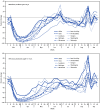Impact of the COVID-19 Pandemic on Administration of Selected Routine Childhood and Adolescent Vaccinations - 10 U.S. Jurisdictions, March-September 2020
- PMID: 34111058
- PMCID: PMC8191867
- DOI: 10.15585/mmwr.mm7023a2
Impact of the COVID-19 Pandemic on Administration of Selected Routine Childhood and Adolescent Vaccinations - 10 U.S. Jurisdictions, March-September 2020
Abstract
After the March 2020 declaration of the COVID-19 pandemic in the United States, an analysis of provider ordering data from the federally funded Vaccines for Children program found a substantial decrease in routine pediatric vaccine ordering (1), and data from New York City and Michigan indicated sharp declines in routine childhood vaccine administration in these areas (2,3). In November 2020, CDC interim guidance stated that routine vaccination of children and adolescents should remain an essential preventive service during the COVID-19 pandemic (4,5). To further understand the impact of the pandemic on routine childhood and adolescent vaccination, vaccine administration data during March-September 2020 from 10 U.S. jurisdictions with high-performing* immunization information systems were assessed. Fewer administered doses of routine childhood and adolescent vaccines were recorded in all 10 jurisdictions during March-September 2020 compared with those recorded during the same period in 2018 and 2019. The number of vaccine doses administered substantially declined during March-May 2020, when many jurisdictions enacted stay-at-home orders. After many jurisdictions lifted these orders, the number of vaccine doses administered during June-September 2020 approached prepandemic baseline levels, but did not increase to the level that would have been necessary to catch up children who did not receive routine vaccinations on time. This lag in catch-up vaccination might pose a serious public health threat that would result in vaccine-preventable disease outbreaks, especially in schools that have reopened for in-person learning. During the past few decades, the United States has achieved a substantial reduction in the prevalence of vaccine-preventable diseases driven in large part to the ongoing administration of routinely recommended pediatric vaccines. These efforts need to continue even during the COVID-19 pandemic to reduce the morbidity and mortality from vaccine-preventable diseases. Health care providers should assess the vaccination status of all pediatric patients, including adolescents, and contact those who are behind schedule to ensure that all children are fully vaccinated.
Conflict of interest statement
All authors have completed and submitted the International Committee of Medical Journal Editors form for disclosure of potential conflicts of interest. No potential conflicts of interest were disclosed.
Figures

References
-
- CDC. Interim guidance for routine and influenza immunization services during the COVID-19 pandemic. Atlanta, Georgia: US Department of Health and Human Services, CDC; 2020. Accessed November 24, 2020. https://www.cdc.gov/vaccines/pandemic-guidance/index.html
-
- CDC. Routine vaccination during the COVID-19 outbreak. Atlanta, Georgia: US Department of Health and Human Services, CDC; 2020. Accessed November 24, 2020. https://www.cdc.gov/vaccines/parents/visit/vaccination-during-COVID-19.html
MeSH terms
Substances
LinkOut - more resources
Full Text Sources
Medical
Miscellaneous

